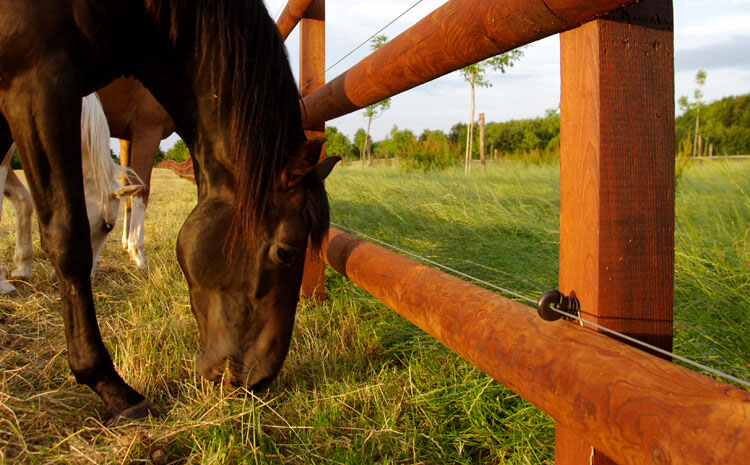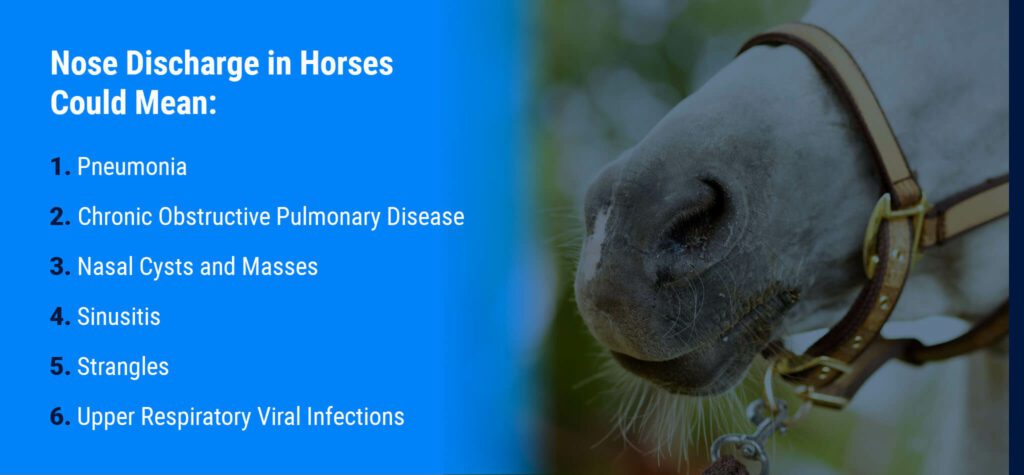Discharge from My Horse’s Nose — Should I Be Concerned?

A horse may have discharge coming from only one nostril or from both, but either scenario can mean there’s a problem.
Discharge from one nostril usually indicates a sinus infection, abscessed tooth or a cyst/mass irritating the nostril. When both nostrils have a discharge coming from them, it is almost always a bacterial or viral infection that requires treatment with antibiotics and/or supportive care.
Recognizing Types of Discharge from Your Horse’s Nose

When there’s discharge from your horse’s nose, your horse should be checked by a veterinarian. Here are some of the diseases or infections that can cause nasal discharge, in addition to a variety of other symptoms:
Pneumonia
Pneumonia is a bacterial infection of the lungs that restricts normal breathing by clogging a horse’s lungs with fluids and pus. A horse’s respiratory tract already contains bacteria called commensals that do not cause pneumonia in healthy horses. However, if the horse’s respiratory tract is compromised by allergies or viral infections, commensals can become trapped in the lungs, multiply rapidly and facilitate the development of pneumonia.
Risk factors for pneumonia in horses include:
- Being under consistent physical stress or psychological stress (overcrowding).
- Not being allowed to graze and run (horses cannot expel pathogens and allergens from their lungs effectively when restrained for long periods).
- Being given general anesthesia.
- Not receiving vaccination against influenza.
Signs of possible pneumonia in horses include fever, loss of appetite, lethargy, shallow breathing and a noticeable nasal discharge. They may also shake their head back and forth in an attempt to clear their nose. Intramuscular or intravenous injections of antibiotics are essential for eliminating bacterial pneumonia in horses.
Chronic Obstructive Pulmonary Disease (COPD)
COPD is a common respiratory illness in horses that is caused by an allergic reaction to fungal spores found in the environment, straw and hay. It frequently affects horses in winter because they are stabled more and in constant contact with materials containing fungal spores. Airways irritated by these spores react by increasing the production of mucus and fluids. This thickens the airways, creates nasal discharge and makes it difficult for the horse to breathe normally.
It’s easier for a horse with COPD to contract other bacterial infections as their immune system is already compromised. Some symptoms of a secondary bacterial infection can include fever and reduced appetite.
When caught in its earliest stages, any lung damage caused by COPD is reversible. The primary treatment for COPD involves allowing horses to graze as much as possible, feeding them alfalfa pellets and using shavings for bedding. Be aware that although soaked hay may seem less dusty, it is still full of fungal spore.
Nasal Cysts and Masses
Cysts and masses may grow anywhere in a horse’s respiratory tract. Symptoms of cysts, tumors or granulomas (produced by viral or bacterial infections) are: Increased nasal discharge (may contain blood).
- Increased nasal discharge (may contain blood).
- Rapid breathing.
- Respiratory noises.
Cysts and masses almost always require surgical removal.
Sinusitis
Sinus infections in horses may be “stand-alone” infections or the result of untreated dental diseases. Typically, horses with sinusitis exhibit discharge from one nostril that may be streaked with blood. Facial swelling may be evident as well. Radiographs and endoscopy help vets diagnose sinusitis in horses. Although antibiotics usually eradicate a bacterial sinus infection, surgery is sometimes necessary to remove abnormal tissues and restore normal drainage.
Strangles
Caused by the streptococcus equi bacteria, strangles primarily affects the upper respiratory tracts of horses between one and five years old. Clinical signs of strangles include a yellow nasal discharge from both nostrils, chronic cough, rapid breathing and lack of appetite.
Many horses also develop lower jaw swelling resulting from abscesses in the submandibular lymph nodes. Anti-inflammatory medications, penicillin or antibiotics expedite recovery from strangles. Since strangles is infectious, horses diagnosed with strangles will need isolation until clinical signs have disappeared.
Upper Respiratory Viral Infections
Horses pick up viral infections from other horses by inhaling aerosol droplets sneezed or coughed into the air by an infected horse. Common viral infections that cause nasal discharge include equine rhinovirus, equine influenza and equine viral arteritis.
Horses suffering from a possible respiratory viral infection may cough, have swollen lymph nodes, seem lethargic and have noticeable nasal discharge coming from both nostrils. Since antibiotics are useless against viral infections, treatments for equine viral infections involve rest, access to plenty of water and isolation in a well-ventilated area. Hay and feed also need to be dampened to reduce the number of allergens and other particulates the horse could inhale.
Improve Equine Immune System Functioning with Kauffman’s® Horse Supplements
Our equine health supplements contain ingredients that contribute to supporting your horse’s overall health. Zinc, copper, omega 3 and glucosamine are just a few ingredients we include in our equine supplements that may improve your horse’s digestive system and immune system. These ingredients can also provide joint and hoof support and balance any general mineral/vitamin deficiencies.
Kauffman’s also offers monthly specials on one or two products. To receive notice of these specials, please join our mailing list via our website or by visiting one of our social media sites.

